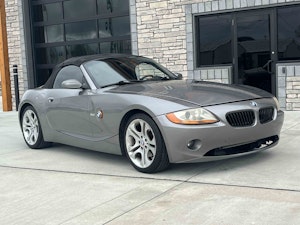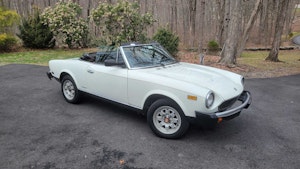Media | Articles
Never Stop Driving #136: Autonomous Takedown
I’ve been meaning to check in on the state of driverless cars, and a new video from YouTuber Mark Rober provided the perfect entry point. Rober is the former NASA and Apple engineer who has developed a knack for explaining complex scientific and engineering concepts, garnering an audience of tens of millions along the way. This week, he ingeniously and hilariously illustrated the performance difference between two driver-aided hardware setups: Tesla’s camera-only system against the camera-plus-lidar arrangement used by Lexus.
(Pro tip: Don’t be put off by the first 8 minutes of this video, during which Rober smuggles a lidar sensor onto Disneyland’s Space Mountain to explain the principles of lidar. It’s a hoot and leads logically to the Tesla vs. Lexus smackdown that follows.)
These hardware systems, commonly found in today’s upmarket new cars, are the foundation of future driverless cars. Lidar uses light pulses to measure the distance to an object. It’s like those systems we’ve watched in submarine movies, the main difference being that sonar uses sound to measure distance, while lidar uses light. Lidar units are expensive, which might be why Tesla relies solely on cameras.
I asked Grok, the AI tool owned by Elon Musk, if any other companies rely on just cameras, and it responded, “The vision-only trend is growing, but it remains a minority approach outside of Tesla’s large-scale implementation.” It followed up with, “Most major autonomous vehicle developers, like Waymo and Cruise, still use a combination of cameras, radar, and lidar for redundancy and enhanced perception, especially in challenging conditions.”
Marketplace
Buy and sell classics with confidence
In Rober’s fascinating video, he drove a Tesla, on Autopilot, into a foamboard wall that was covered with fabric printed with a photo that mimicked the road he was traveling on. The on-board computers, relying only on vision-based cameras, were fooled and the Tesla went right through the wall. The Lexus did not.

I’ve watched Rober’s videos for years. My favorites are the ones where he designed and built backyard obstacle courses for squirrels. Watch this one and you will never look at the bushy rodents the same again. Rober’s enthusiasm for science, engineering, and the quirky questions of life—can you swim in Jell-O?—is wonderful. His videos show a hyper-curious, extraordinarily clever guy experimenting rather than a typical YouTuber doing stunts for clicks. Among the thousands of comments on his Tesla/Lexus video, some claimed the test was rigged, but I sure couldn’t detect any obvious flaws.
Indeed, Rober devised brilliantly simple visual tests that showed how each system performed. He also simulated a rainstorm and fog to see if each manufacturer’s system could detect a kid standing in the road. Incredibly, there are no universal regulations or agreed-upon tests governing such matters. Rober is way ahead of federal regulators and his video clearly illustrates what I and others have been saying for years: “Autopilot,” the label Tesla uses for its driver-aid systems, is irresponsible at best.
Other commenters on Rober’s video recognized the extraordinary times we’re in. “Making enemies with Tesla and with Disney with only one video,” one wrote. “This is commitment.” Cue the outrage machine, which is already spinning with Tesla defenders. The New York Post reported on the claims that the video is a hoax. Rober’s no dummy, however, and he likely saw future challenges to his videos.
Meanwhile, Zoox, the Amazon-funded autonomous taxi company, is close to deploying a small fleet in San Francisco. Waymo remains the clear leader and continues operating in Phoenix, San Francisco, and Los Angeles. Progress on autonomous technology remains a slow, expensive endeavor.


I’m reminded of the hype that initially surrounded autonomous technology. I bought into the narrative that driverless cars would be everywhere by now. Investors poured hundreds of billions into research and development. If anyone really knew how hard it would be to develop the technology, they kept quiet, encouraged the PR puffery, and let the investment gold rush in. It turns out the tech is real but was way overpromised.
Which brings to mind a book I’m reading called Poor Charlie’s Almanack: The Essential Wit and Wisdom of Charles T. Munger. It’s a compilation of speeches and talks given by Charlie Munger, who, until he died in 2023, was Warren Buffet’s right-hand man. Munger said the duo avoided investing in tech companies because they instead were biased toward simple businesses and didn’t think they properly understood much that the tech industry peddles. Is AI another gold rush? I got a sense it might be when I learned that ChatGPT hasn’t updated its information since October 2023. I subscribe to the service and when it seemed like the answers I got were old, I asked the age of its database. It replied, “My training includes information up to October 2023.” You’d think it would be current, right?
I turn 55 next month and I wonder if that coincides with my growing cynicism for the tech industry. I enjoy parts of social media like everyone else, but I hate how those platforms gutted the business model of traditional media, where I’ve spent most of my career. Now the major media outlets can’t afford many deep investigations, so they resort to parking journalists in D.C. and endless reporting on the Washington soap opera with ginned-up click-bait headlines. The bologna on social media is not a substitute despite what the tech utopians claim.
I’m dangerously veering into old-guy-ranting-from-his-porch territory, so let’s get back to cars. Here’s this week’s list of material to get you through the weekend. There’s much more available so make sure you sign up for our newsletters.
- 1986 Mitsubishi Starion left for dead. Sigh, I dig those cars.
- McPherson College and its automotive restoration program was featured on CBS Sunday Morning.
- 1978 Lincoln Town Coupé: Gilded Pullman Coach.
- Chasing 200 MPH at Bonneville in a British-American Hybrid.
This Jeep CJ, currently being auctioned on Hagerty Marketplace, would be a terrific summer cruiser.
Have a great weekend!
Larry
P.S.: Your feedback and comments are welcome.
Please share this newsletter with your car-obsessed friends and encourage them to sign up for the free weekly email. The easy-to-complete form is here. And if you’d like to support the efforts of Hagerty Media and receive the award-winning Hagerty Drivers Club magazine, please consider joining the Hagerty Drivers Club.















My granddaughter sat me down and made me watch the squirrel videos, and I was stunned and amazed. That guy is a genius. I will now go to YouTube for the rest of the evening. Really appreciate your columns, you are a great writer.
I must be missing something because this just seems like another clickbait video this article seems to bemoan. One can argue the details of Tesla’s system, but to me that’s a red Herring. The litmus for whether this video is more than clickbait is if the test is even representative of a real world scenario. Given the number of Wile E. Coyote jokes I think that tells me that it’s not. Why does that matter? First, these systems absolutely need to be analyzed through a critical lens for safe implementation. And the cost and complexity of the systems should not compromise on that. However, one must also balance the likelihood of the thousands of scenarios such a system will encounter when trying to determine a “safe enough” system. Because systems designed for the most ridiculous situations (the 99.99 percentile customer) adds cost to everyone’s vehicle as well as increasing repair costs. These last two things I think this site’s commenting members also bemoan.
Why do I care personally? Because one day I will not be able to drive safely. But I will still want the freedom an automobile provides in the USA. And self driving tech is the only thing I see as enabling that when that time comes.
I remember being at a Lexus event where they wanted us to not hit the brake and let the system sense the obstacle and then hit the brakes. I hated it as it was a last minute panic braking situation the car would initiate. I let someone else do it, no thanks I don’t trust the tech. I still don’t trust it on the obviously more advanced tech out now.
I remember reading a few years ago that the future of autonomous driving vehicles, because of the multiple technologies needed to make them safe, would be in fleet use where the additional costs could be justified. In your newsletter you wrote, ‘Lidar units are expensive, which might be why Tesla relies solely on cameras.’, which supports what I had read. However, with the recent organized/ encouraged vandalism done to Tesla vehicles, perhaps the timing of this YouTube video, and your inclusion of it in your newsletter, might be interpreted as dipping a toe into the political waters. Just sayin’…
I do enjoy your weekly newsletters, the Hagerty Drivers Club magazine and other communications from Hagerty.